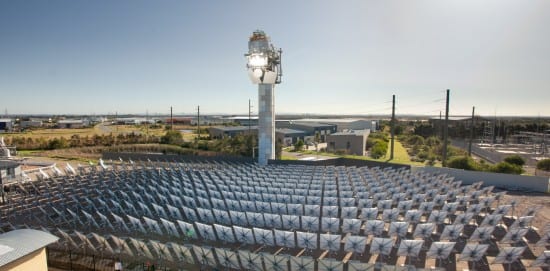Last Friday, the Coalition made a low-key announcement of its new Low Emissions Technology Roadmap. To be developed by the CSIRO, it will aim to “highlight areas of growth in Australia’s clean technology sector”.
Unveiled jointly by the industry and science minister, Christopher Pyne, the environment minister, Greg Hunt, and the energy minister, Josh Frydenberg, the plan asks the CSIRO to identify the most promising ways to reduce emissions and to come up with plans to accelerate the development and commercialisation of Australian technologies such as solar panel components.
With the election campaign in full swing and announcements coming thick and fast, some will obviously get more airtime than others. Still, it was surprising to see this one quietly released on a Friday afternoon, given the seniority of the ministers involved, not to mention the importance of both renewable energy and greenhouse emission reductions as issues in this election.
It’s also not immediately clear what is actually involved in developing a “technology roadmap” like this. It might conceivably follow a model previously developed at the US Sandia National Laboratories, which identified three key elements:
- preliminary activity, which involves defining the project’s precise scope
- developing the roadmap, by deciding which technologies to include and defining specific targets for their development
- follow-up, by working out how the plan is actually going to be implemented.
The announcement in itself has kick-started the first of these three stages. CSIRO has been given the lead for the second element. But it is the third stage – the actual implementation – where roadmaps typically lose their way. Many governments have set roadmaps in the past, only for successive ones to choose different objectives and therefore move down a different path.
The key for any roadmap to deliver its intended outcome is the successful implementation of its proposals. The policy and, crucially, the funding committed to the project will determine whether the ultimate objectives are met.
Pay to play
In the announcement’s press release, Pyne said the roadmap would “achieve a large-scale technology transformation”. But looking at the steps above, this will require policy and investment in those technologies that are to drive the transformation process.
While this announcement supports previous policy pledges, notably the A$1 billion Clean Energy Innovation Fund unveiled two months ago, will this be enough to drive the crucial third stage of the roadmap: developing commercial-scale clean energy generation to the level required to make serious inroads into emissions reduction?
In the past Australia has tended to adopt the cheapest available energy technologies, particularly given that much of the electricity sector is moving from public to private-sector ownership.
Will this change now, Frydenberg’s statement that “the Coalition is committed to a technology-neutral approach to energy policy” would suggest that it may not.

With the minimal growth in electricity demand over recent years, new generation on a large-scale will need to be more economical than existing assets, or else policy measures should be put in place to make the new technologies competitive.
Part of the Coalition’s plan, as also stated by Frydenberg, is to ”help identify opportunities for Australian businesses to be involved in the global energy supply chain, with the potential of creating new industries that create new jobs and growth in Australia”. History has shown that while Australia has been a very innovative nation, much of the technology developed here tends to move offshore.
Pyne added that “by 2018 Australian solar technology will be embedded in over 60% of the world’s [photovoltaic] panels”. But how much of this global supply chain has created jobs and growth in Australia?
Hunt also stated that the roadmap will help Australia meet its greenhouse emissions target, which calls for a 26-28% reduction on 2005 levels by 2030. But 2030 is not that far away, and the process of drawing up roadmaps, developing technologies and then commercially deploying them takes time. Support for existing mature technologies, such as solar and wind energy, must be continued in the meantime.
While existing agencies such as the Australian Renewable Energy Agency (ARENA) and the Clean Energy Finance Corporation support these technologies, ongoing funding is a constant subject of debate within the government. These bodies will jointly administer the new Clean Energy Innovation Fund, but if this new roadmap is to be a success, ARENA’s funding must continue beyond its currently planned expiry date of 2022, and the CEFC needs a longer business plan than the current one which runs to 2019.
In the meantime, it pays to think carefully about the initial phase for the roadmap: defining its precise scope. According to the announcement, the areas to be considered include “renewable energy, smart grids, carbon capture and storage, electric vehicles and energy efficiency” – all areas in which CSIRO has existing research programs. As such, it is well placed to understand the challenges, the investment needed, and realistic time frames for implementation. All of these need to be identified and quantified precisely, given that the plan only spans a few years.
Introducing innovative technology into an existing sector, which is already working, will always draw resistance, particularly from the operators (as well as equipment manufacturers, maintenance companies and fuel suppliers) of existing generation assets. But, of course, decisions about electricity generation have much wider effects than just the provision of energy.
The need to reduce emissions affects every aspect of how we will live our lives in the future. No major political party disputes the need to move from existing technology to a clean energy future. But policy, with sufficient financial backing, needs to be put in place now and supported by successive governments to have any chance of hitting the deadlines we face.
This article was originally published on The Conversation. Re-produced with permission. Craig Froome is Clean Energy Program Manager at the Global Change Institute at The University of Queensland.











